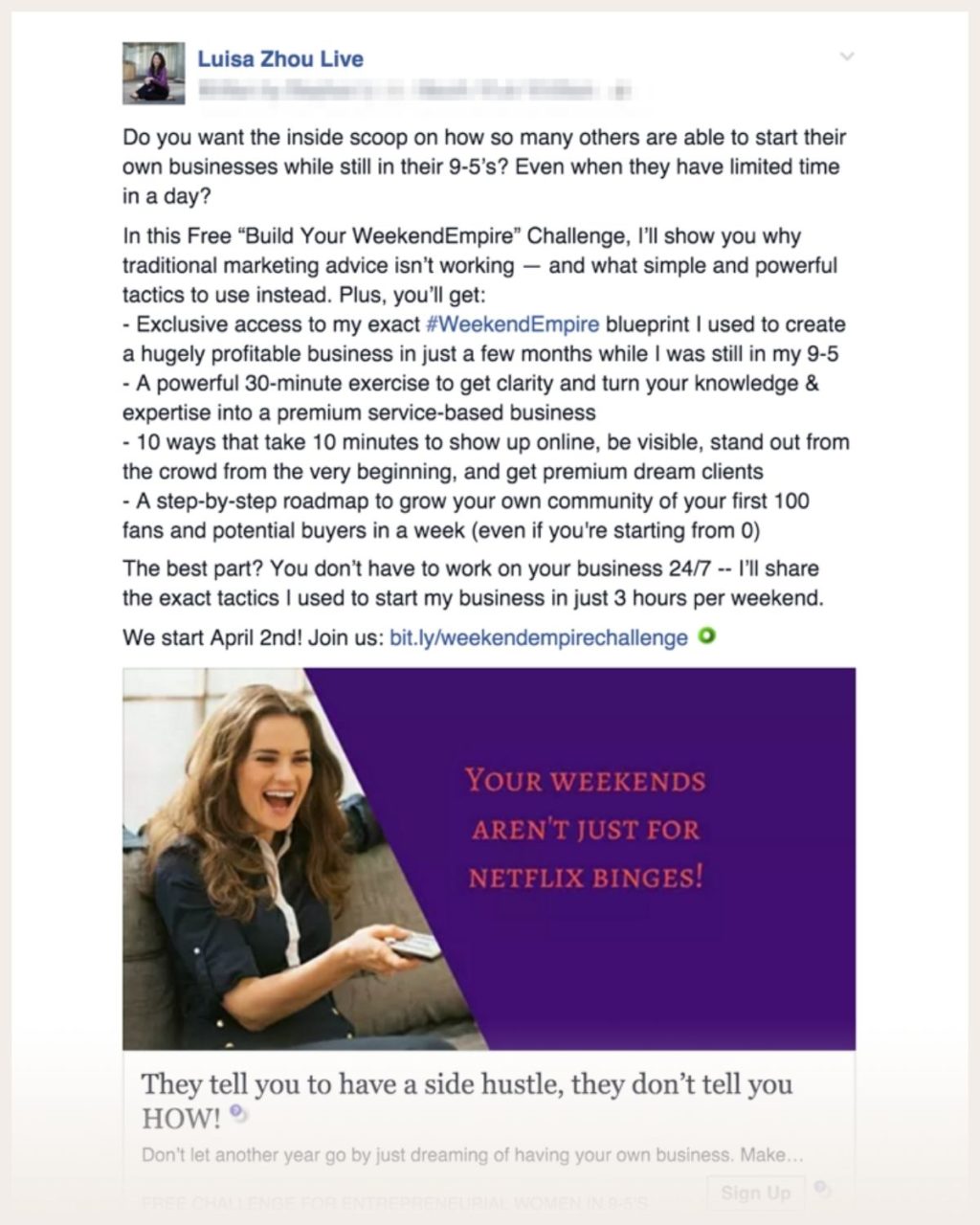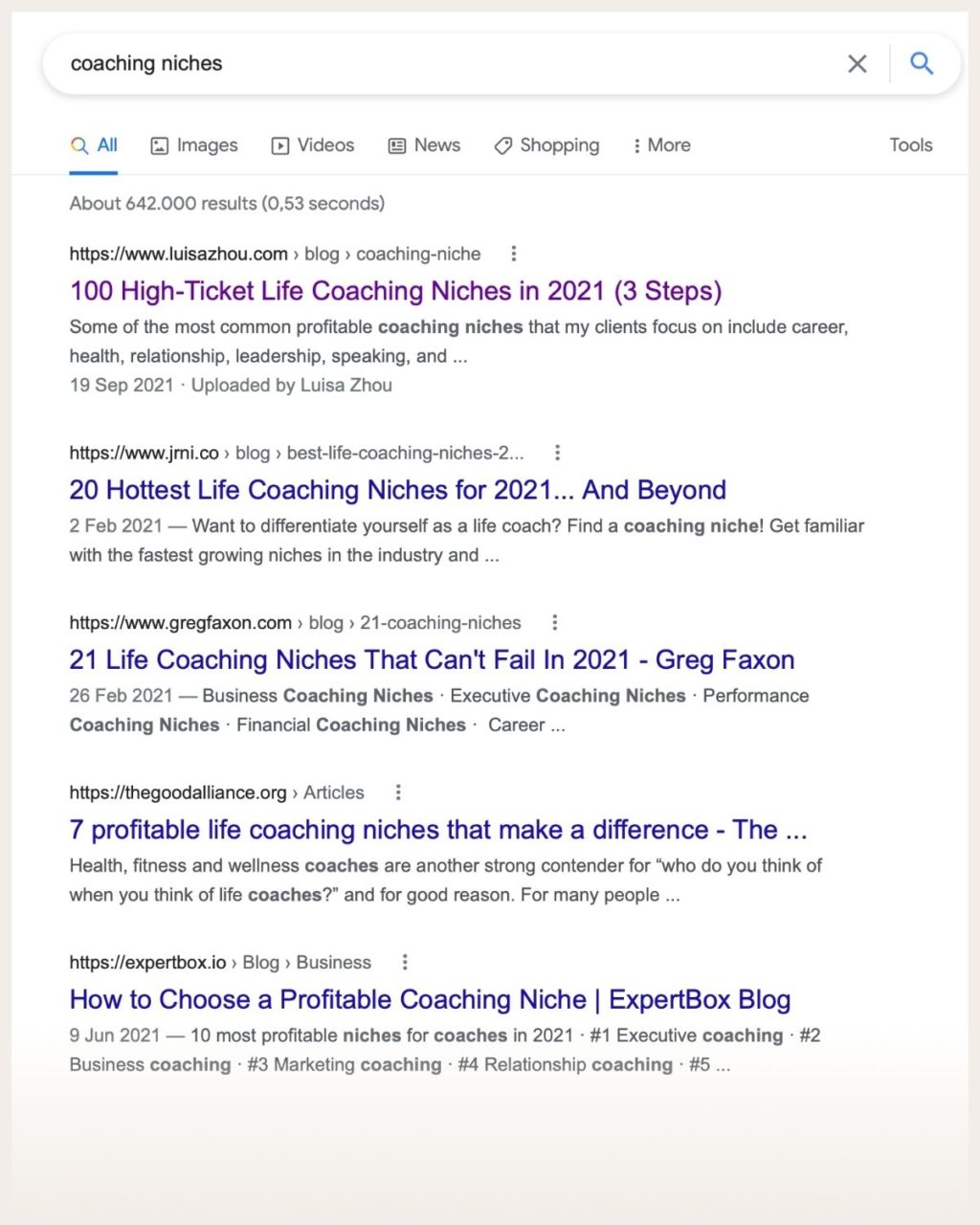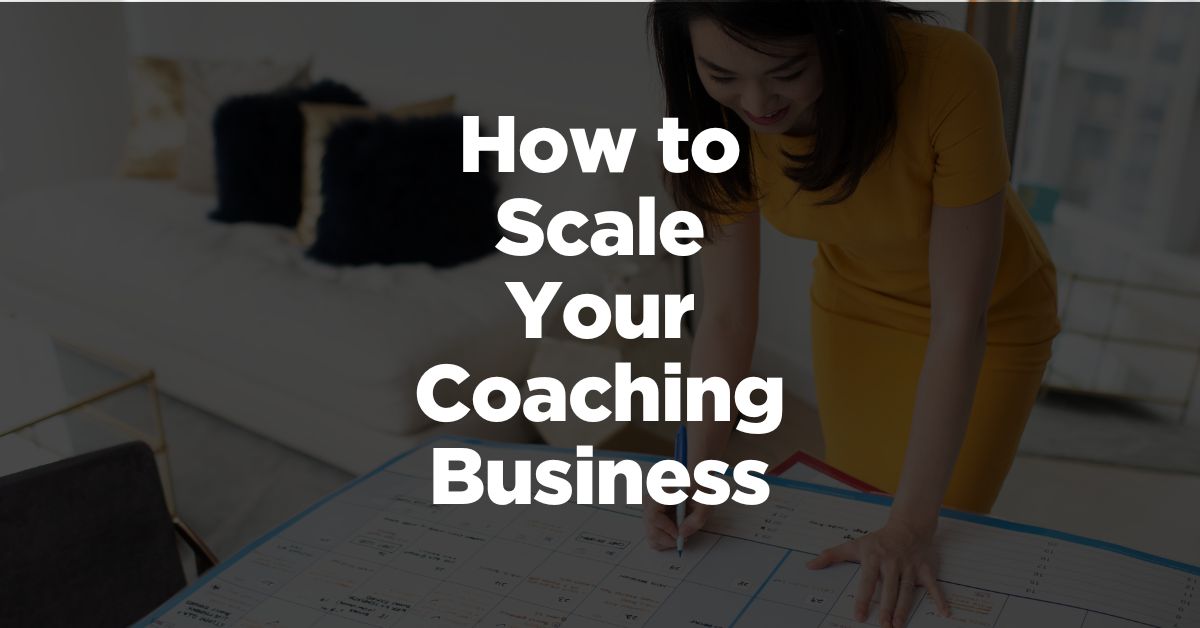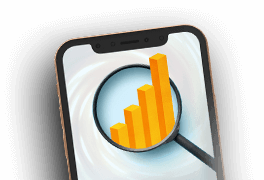Want to know how to scale your coaching business?
You’re in the right place. Today, you’ll learn how to go from six-figures to a multiple-six or seven-figure business.
Want to learn more? Read on!
Is coaching scalable?
Can you turn your experience from one-on-one coaching into a service or product that lets you leverage your time and scale your revenue…without working more?
Yes, you can. But what you’ve done so far to build your business probably won’t help you go from five or six figures to $20K, $50K, $70K, or more months.
Let me explain:
A lot of people started their online businesses around the same time I did. Quite a few of them hit six figures. Some of them, a lot more.
Most of them though, I don’t see around anymore.
Because they hustled and made some money…and couldn’t repeat the process.
I wasn’t better than any of them. But I did have a better process.
A process that built my business from $8,000 to $101,000 to $800,000.
What’s more, it was a repeatable process that consistently generated unheard-of sales and profits over six launches. Each of which systematically took me one step closer towards building a multiple 7-figure business and an audience of 100,000+. From scratch.
But before we look at that process and how you can use it, let’s define what it is your coaching business actually does.
What is a coaching business?
Let’s start by defining what a coaching business is. A coaching business is a service business where you as the coach support your clients in getting the results they want. The value you provide is done via your coaching — that you have a system and experience in helping people achieve similar results.
As such, a coaching business isn’t scalable because your time is limited and you can only work with so many one-on-one clients. In fact, the average coach makes $62,500/year in the US. So most coaches never grow their businesses.
That’s why, when you want to scale your business and stop being limited by your personal time, you need to change your offer.
Just a quick note: If you’re just in the process of starting a coaching business, this article isn’t for you. Instead, take a look at these resources that show you how to start an online coaching business step-by-step:
- 100 High-Ticket Coaching Niches (Choose among 100 coaching business ideas — or use my methodology to find your own, unique niche)
- How to Start a Successful Coaching Business (Learn what it takes to grow a 6-figure coaching business from scratch)
- How to Sell High-End Coaching Packages (Create coaching packages that stand out)
But if you’re at the 5- or 6-figure mark, it might be time to scale. Let’s take a look at what this means.
How to scale your coaching business
There are two ways to scale your coaching business. You can use brute force to do more in your business. Or you can focus on growing steadily, while you build a business that lets you free up your time.
I chose the latter. But while my business growth has been phenomenal, I’ve often heard from mentors and colleagues that it could be much faster if I pushed my launches further, used social media more, or scaled a sales team.
I’ve tested all of these things and they’re great. But I’ve always wanted more freedom to grow my business while not having to do those things.
Which is why I focused on my traffic, sales, product, and marketing systems, so that I can now grow my business without having to do big live launches, live webinars every week, or be on social media every day.
And that’s how I scale my business — with the right offers and traffic. Let’s take a look at both.
The 4-Step Automatic Attraction System
for attracting more clients daily... without paid ads, social media, or "hustle"!
What coaching offers can you scale?
One of the biggest mistakes people make is to create a lot of offers instead of focusing on one. But if you have several programs and courses, you also need to sell and manage them. And that takes a lot of extra time and energy.
That’s why you should scale what you’ve already built and not constantly build new products.
You can choose between a few alternatives:
First, to create one high-end group coaching program.
Second, to create a two-step offer. In this case, you have an entry-level type of offer (a course) that leads into a higher-end program (group coaching or a higher-end course).
Third, an online self-study course. By creating a high-value course, you can sell it at a price point of $1,000-$2,000.
I personally sold a hybrid group program, Employee to Entrepreneur, for the first four years of my business. I included a lot of support into the program (group calls, support coaches, and so on), which, again, meant that I could sell it at a higher price point. (Today, ETE is an evergreen, self-study course.)
Regardless of the offer you choose, you need to master a sales process that helps you sell your offer. That’s what we’ll look at next.
Master a sales system
You can create a sales system in a few different ways:
The first option is to get people to come in via a free training, where you invite them to book a sales call. On the sales call, you (or a salesperson you hire) sell your program.
Or you hold launches throughout the year. Launches build up momentum and awareness for your product and they can almost be compared to a movie premiere (that builds up hype for a new movie). You can hold launches once a year or a few times throughout the year.
I love launches and I used my own launch framework to launch Employee to Entrepreneur. That’s how I was able to scale from $8,000 to $100,000 to $800,000 in my first year. My launches brought in $800,000+ per launch, so they can be very effective for scaling your business fast.
The third option is to use an evergreen sales system.
These days, I use an evergreen funnel, which means that I use lots of traffic sources and courses, and my systems are set up in a way that continues to scale every month. I don’t actively sell anything and thanks to my systems, I work around 5-10 hours/week.
Evergreen funnels take time to master, so gradually switch to one when you’ve started scaling your business.
Master your numbers
When you’re scaling your coaching business, it becomes more important than ever to master your numbers.
Usually, people who are at six figures but can’t seem to scale don’t know their numbers. In other words, they’re not taking a high-level CEO approach to their business.
There are three numbers you should master:
- Sales conversion rate: How many people who go through your system end up buying? If one out of 100 buys, you know how much traffic you need to reach your income goal.
- Cost per lead: How much does it cost to acquire a new client? When you know this number, you understand how much you can spend on a lead in order to be profitable. As you don’t want to make what you spend, you’ll want to get this number as low as possible so that you increase your profit margins.
- Your sales cycle: How long does it take between someone finding you to them buying from you? For example, it might take 3 days for someone to buy. If you know your average sales cycle length, you don’t freak out if you don’t make a sale on day 1 or 2.
These three numbers can make or break your business, so track them every month.
Next, let’s look at the first type of offer that you can scale — a group coaching program.
How to scale with group coaching
The first offer to scale for coaches is a group coaching program.
Here, your focus is on driving people to a systematized sales process that brings the right people into your group coaching program. (Like running Facebook ads to a really good webinar.)
And to create a group coaching offer, you take what you were teaching your private clients, package it into PDFs and videos so that your clients can learn the “information” on their own time and then attend group coaching calls with you to get the benefit of your coaching.
This lets you take on more clients and scale your business while still delivering great results (super important).
I’ve had students scale to multiple 6-figures with this model. Where you have a $3,000 to $10,000 (or more) group coaching program.

Then, you can also combine group coaching and private coaching. Maybe you sell group coaching at $3,000 and private coaching at $10,000. If someone takes your group coaching offer and wants more of you, then they can coach privately with you. You can play with the math.
How to scale with online courses
Selling a course to scale a business is similar, but your offer is different. You’ll need to create your course, which you build based on your existing coaching offer. You essentially take what you’ve taught your students and turn that into an online self-study course.
How do you create your course, though? Here are my four course-creation rules.
Rule #1: Start with the smallest course possible
Too many aspiring course creators try to turn their first course into their magnum opus. Which ends up by way too overwhelming to create and sell.
Instead, create a “First Steps” course that makes it way easier for you to create, sell, and over-deliver on it.
Rule #2: No “beta” versions
I don’t believe in creating a “beta” course that you give for free to test it out.
Mostly because doing so gives you AND your students’ permission to not take your course as seriously simply because it’s “in beta.”
Instead, offer it first as a 1-on-1 or group coaching program first. You get paid validation, you get paid, AND you create the best course possible from day one (because you’re incorporating actual client feedback).
Rule #3: Use a launch TO GROW your audience
Growing your audience and making sales should not be mutually exclusive events. Instead, use a course launch to capture attention, grow your audience, AND make more sales.
The key to doing so successfully lies in being able to quickly turn strangers into excited customers.
And you do that via three steps:
(1) “Teaching the gap” between what your customers know and what they need to learn from you so they understand why they should buy,
(2) Giving “Step 0” wins that demonstrate why people should believe in you and your course, and
(3) “Amplifying personal connections” so that people are excited to buy and learn from you.
Rule #4: Leverage your launch
After you’ve created and sold out your first course or group program, that’s when you get to reap even greater rewards, such as…
…Being able to offer additional support after the course for students who loved it and want to work more with you…aka increasing your sales by selling your next course or premium coaching package
…Being paid to create the best course possible in the fastest and most efficient way. (Because you’re incorporating feedback from paying clients.)
…Leveraging the momentum and learnings from your first launch to do a bigger second launch (with a lot less work because you’ll have assets and experience).
Now you know how to create the right offer and sales system to scale your coaching business. Next, let’s take a look at how to use the right traffic source.
The 4-Step Automatic Attraction System
for attracting more clients daily... without paid ads, social media, or "hustle"!
How to scale your traffic
On the front end, you need the right traffic source. No matter how good your sales strategy is, you need traffic to drive people to it.
And there’s a mistake I see coaches often make:
They try to master too many traffic sources.
Instead, 7-figure business owners master ONE way to drive traffic.
A coaching business can choose between a few scalable traffic sources:
- Advertising
- Affiliates
- Social media
- Search engine traffic (SEO)
Below, we’ll look at each of these.
Advertising
Advertising refers specifically to paid traffic from Facebook and YouTube (but you can choose between different advertising platforms, such as Instagram or Google).
I originally scaled my business by mastering Facebook ads, and later YouTube ads. Because I was completely focused on this one traffic source, I was able to optimize my campaigns in the most effective way with the highest return so that I was able to scale to 7-figures in one year.

Affiliates
The next traffic source, affiliates, refers to partnering with people who serve a similar audience. They provide the audience and you provide the sales system (aka. the offer and sales funnel).
In return, you offer them a percentage, which is typically between 10-50%.
You partner with several people so that you get clients on a consistent basis.
Social media
Social media means that you use 1-2 social media platforms, such as YouTube, Facebook, or Instagram. This is probably the hardest way because you have to get really good at one of these platforms. And even if you do master the platform to a T, you still can’t control algorithmic changes that are bound to happen.
Search engine traffic (SEO)
Finally, search engine traffic means that you drive traffic from search engines like Google.
People search for queries related to your business and find your website when it appears in search results. And there are a lot of people looking for coaches on search engines. 1.5 million people search for executive coaches, life coaches, and business coaches every month (this number excludes most coaching niches).
To appear on Google, you need to have an optimized website and an SEO strategy in place.

But which traffic source should you focus on?
It depends. The most scalable options are advertising and search engine traffic.
Both have pros and cons. Advertising is fairly simple to set up (although you do need to know how to use ads), but in the long term, ads will eat up a part of your profits. Plus, when you run a 7-figure business, you’ll need someone to manage your ads to free up your time.
On the other hand, search engine optimization (SEO) is much more profitable in the long run. When you’ve built up your traffic, the people who come in are more or less pure profit. However, SEO takes a long time to master and build up, so you might not see any sales for several months.
The 4-Step Automatic Attraction System
for attracting more clients daily... without paid ads, social media, or "hustle"!
Over to you!
There you have it! Now you know how to scale your coaching business.
The 4-Step Automatic Attraction System
for attracting more clients daily... without paid ads, social media, or "hustle"!
What it comes down to is creating the right offer and building traffic to it so that people keep buying your offer without you having to put in more work. You free up your time, increase your income, and grow that business you’ve always dreamt of.
Want to learn more about scaling your business?
Get my 4-step strategy to getting clients every day… automatically!








